You could be excused for thinking that Chinese have the market cornered on electronic dictionaries. You see them on tables in most every cafe you enter, perched above the papers being poured over by some hapless student or business person.
Of course, most of the local people hovering intently over paperwork in cafes are using their dictionaries to look up Chinese definitions of English words. And since English dictionaries are vastly easier and quicker to use, locals who own English-to-Chinese electronic dictionaries might be accused of simply being lazy. But what about the pitiable foreigner visitors and residents of Taiwan whose Chinese language skills aren't up to snuff? Woe are we who are forced to thumb page by page through impenetrable Chinese-to-English dictionaries. Our reasons for buying the fancy digital versions are far less spurious, but anyone who has shopped for a digital dictionary at a local consumer electronics store will have quickly noticed that all the interfaces are in Chinese -- this being Taiwan and all.
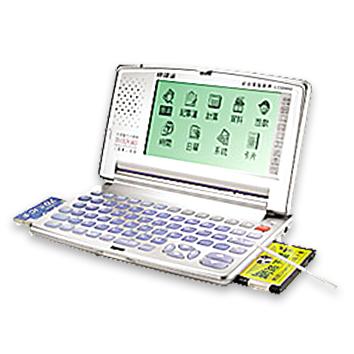
The software running inside these handy little machines is the same whether it's working from Chinese to English or vice-versa. Most of the higher-end models, in fact, operate equally well going either way. An English-language interface, however, is imperative for travelers or anyone in the early stages of their Chinese studies.
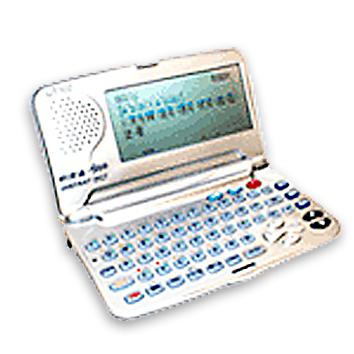
LANGUAGE TEACHER GD700
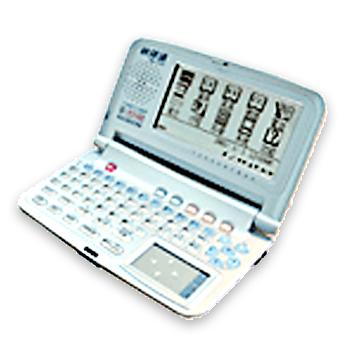
US$200
The Language Teacher line of electronic dictionaries, by Ectaco, are among the best-selling in the world. The company makes digital dictionaries for dozens of languages but has excelled at crafting software that flows seamlessly between Chinese and Roman-alphabet languages. The GD700 is the least-expensive of the company's models to incorporate both English and Chinese electronic voices. (All the devices reviewed here have voice synthesizers to help aid pronunciation, albeit somewhat synthetically.) In the case of the GD700, it will speak in English, Mandarin and Cantonese (I looked to no avail for an English/Mandarin/Taiwanese model) and contains a 500,000-word/character vocabulary. Chinese characters are shown in both their traditional and simplified forms.
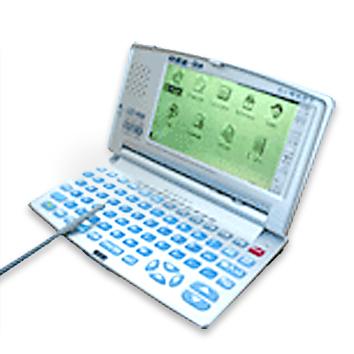
The disadvantage to less-expensive models, however, comes when looking up Chinese characters for which you don't know the meaning or pronunciation. As with most models, the GD700 offers a number of different ways to look up characters, but all are done through keystrokes. It should be said, though, that unless you're already familiar with stroke order and can readily copy a character, you'll probably don't want to use keystrokes to find the character you're looking up. But a better way does exist.
FRANKLIN MD7250
US$240
The better way comes in the form of a stylus pen and touch-screen capability that is available in many models. While this feature adds to the price of the device, it also greatly expands its usability. Don't know how to pronounce a character or what it means? Pick up the pen and write it on the small touchpad adjacent to the keyboard on Franklin's MD7250. The screen above will offer you a list of possible characters as it recognizes your handwriting. The drawback to this type of data-entry is that, unlike some handwriting-recognition software, it does not "learn" your handwriting the more you use it.
With the exception of this feature, the MD7250 is largely similar to the GD700, with a 500,000-word/character vocabulary and synthetic English/Mandarin/Cantonese voice. Higher-end models of the Language Teacher line also have the stylus-input feature, but the Franklin model is notable for being far less expensive than equivalent Language Teacher models, and for having its input pad on the bottom-half of the device -- stylus-input on Language Teacher models is done on the screen itself.
LANGUAGE TEACHER GD986
US$330
The GD986 represents the top of the Language Teacher line. Like the Franklin model, you can use a stylus to enter Chinese characters or tap away at the touch-screen capability, but where either of the aforementioned models might be found packed into a traveler's carry-on bag, the GD986 is for serious students and language professionals. It works not only with Chinese and English, but a total of eight languages. It has a built-in 800,000-word/character vocabulary that can be expanded through the addition of IC cards and downloads. It also helps students through grammar and sentence-building programs that can also be expanded.
There are models in the Language Learner line between this model and the GD700 that contain some of these features -- the EC5900HV, for example, also offers grammar tutorials -- but none have all the bells and whistles of the GD986, nor its hefty price tag.
INSTANT LD9988 SUPER
US$200
Instant Corp is a local manufacturer of top-selling electronic dictionaries. It's LD9988 Super, like Language Teacher's GD986, represents the top of the company's line. It is the equal of the GD986 in most every respect. It's built-in dictionary recognizes nearly a million words/characters and its grammar tutorial programs can be expanded through IC cards and Internet downloads. The two big differences between the LD9988 and the GD986, however, is that this locally manufactured model costs US$130 less, and that its interface is in Chinese. Despite the Chinese interface, it deserves a mention here. Why? If you're in the market for a machine that can do all that these last two models can, a Chinese-language interface is likely no problem for you. It must be said, however, that the expandable tutoring programs available for the LD9988 are strictly for Chinese speakers learning English.
One last note on electronic dictionaries: If you don't need a device you can stick in your pocket and you already own a computer, you can knock US$100 or more off the price of a digital dictionary by buying only the software. Some of the best brands available in this category are Dr. Eye, KuaiXue and Wenlin, the latter of which especially is an excellent tool for learning Chinese. The drawback to most of these programs is the lack of stylus input. But for the difference in price, it might be worth a few extra keystrokes.
Check out www.translation.net for a detailed run-down of popular electronic dictionaries.
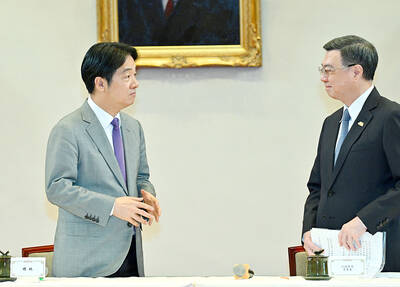
Under pressure, President William Lai (賴清德) has enacted his first cabinet reshuffle. Whether it will be enough to staunch the bleeding remains to be seen. Cabinet members in the Executive Yuan almost always end up as sacrificial lambs, especially those appointed early in a president’s term. When presidents are under pressure, the cabinet is reshuffled. This is not unique to any party or president; this is the custom. This is the case in many democracies, especially parliamentary ones. In Taiwan, constitutionally the president presides over the heads of the five branches of government, each of which is confusingly translated as “president”
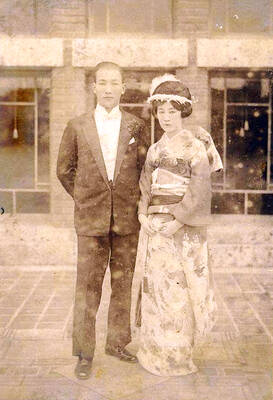
Sept. 1 to Sept. 7 In 1899, Kozaburo Hirai became the first documented Japanese to wed a Taiwanese under colonial rule. The soldier was partly motivated by the government’s policy of assimilating the Taiwanese population through intermarriage. While his friends and family disapproved and even mocked him, the marriage endured. By 1930, when his story appeared in Tales of Virtuous Deeds in Taiwan, Hirai had settled in his wife’s rural Changhua hometown, farming the land and integrating into local society. Similarly, Aiko Fujii, who married into the prominent Wufeng Lin Family (霧峰林家) in 1927, quickly learned Hoklo (commonly known as Taiwanese) and

The Venice Film Festival kicked off with the world premiere of Paolo Sorrentino’s La Grazia Wednesday night on the Lido. The opening ceremony of the festival also saw Francis Ford Coppola presenting filmmaker Werner Herzog with a lifetime achievement prize. The 82nd edition of the glamorous international film festival is playing host to many Hollywood stars, including George Clooney, Julia Roberts and Dwayne Johnson, and famed auteurs, from Guillermo del Toro to Kathryn Bigelow, who all have films debuting over the next 10 days. The conflict in Gaza has also already been an everpresent topic both outside the festival’s walls, where
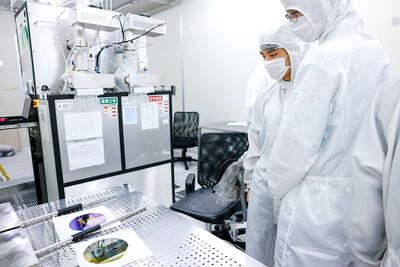
The low voter turnout for the referendum on Aug. 23 shows that many Taiwanese are apathetic about nuclear energy, but there are long-term energy stakes involved that the public needs to grasp Taiwan faces an energy trilemma: soaring AI-driven demand, pressure to cut carbon and reliance on fragile fuel imports. But the nuclear referendum on Aug. 23 showed how little this registered with voters, many of whom neither see the long game nor grasp the stakes. Volunteer referendum worker Vivian Chen (陳薇安) put it bluntly: “I’ve seen many people asking what they’re voting for when they arrive to vote. They cast their vote without even doing any research.” Imagine Taiwanese voters invited to a poker table. The bet looked simple — yes or no — yet most never showed. More than two-thirds of those